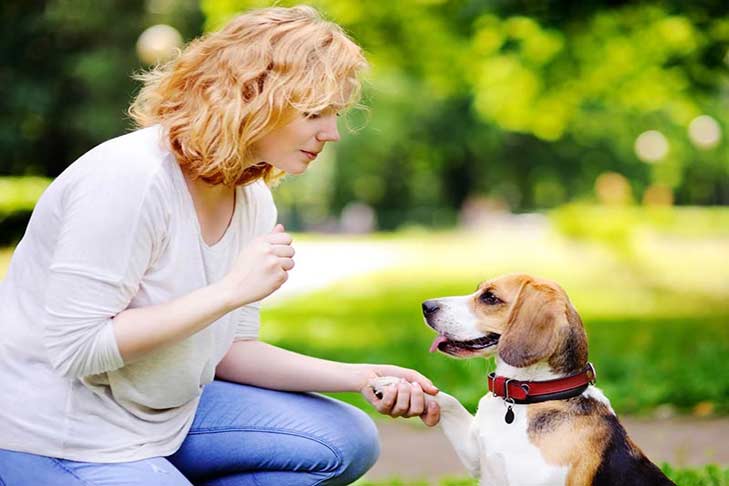
You may have seen deaf dogs responding to the hand signals of their owners, and perhaps, you use hand signals with your own dog. But no doubt, you do a lot of talking to your dog, too. Have you ever wondered which would be easier for him to understand, spoken words or visual cues? What is the most effective way of communicating with your dog? Recent research from Nihon University, in Japan, helps answer this question.
Recent Research
Megumi Fukuzawa and Marina Watanabe looked at how sight, sound, and smell can cue dogs to a person’s presence. They tested 11 dogs in an experiment that allowed the dogs to detect the presence of a person by smell only, sight only, sound only, or using all three senses at once. They timed the dog in each situation to see how long it took him to find the person in the testing room and get a treat.
As you would expect, the dogs found the person almost every time when they had all three cues – sight, sound, and smell. When it came to only one cue at a time, the sight, sound, and smell situations were each about equally effective in helping the dog, although none was as effective as all three cues at once.
The interesting detail is in how quickly the dogs located the person. In the situation with all the cues and in the sight-only situation, the dogs were about three times faster than in the sound-only situation. In other words, seeing the person was far more effective than only hearing her. In the smell-only condition, the dogs were slower than they were with all the cues or with the sight cue, and they were faster than in the sound-only situation. However, these differences were not significant.
Seeing the person, rather than smelling him or hearing him, also led to more tail wagging by the dogs. So visual cues seem to be the most exciting for dogs, at least in terms of locating humans. The researchers concluded that although sight, sound, and smell are all important for dogs when interacting with people, sight seems to provide a noticeable advantage.
Hand Gestures and Body Language
How can you apply this study to your training and other communication with your dog? It’s helpful to appreciate that visual cues are more important to dogs than we might think. Humans are a very sight-reliant species, so it’s surprising that we do so much talking to our dogs. Many people expect their dogs to listen to their words alone, and never teach hand signals for basic behaviors, such as sitor down. However, dogs are more likely to be in touch with what we are doing than what we are saying.
Hand signals are easy to teach, particularly if you use lure-and-reward training. For example, the common hand signal for sit, raising your hand from your side to be parallel with the floor, comes from holding a treat to your dog’s nose and lifting it over his head to lure a sit position. Although it is best to train using the hand signal first, even if you have already taught a verbal cue, you can add a hand signal later by giving the hand signal before you say the verbal cue. After enough repetitions, your dog will learn that the hand signal means the same thing as the word.

Other research has shown that a dog’s ability to learn is influenced, not just by hand signals, but also by overall body language and the distance between the trainer and the dog. It seems the farther the trainer is from the dog, the less responsive the dog will be. Therefore, it pays to be aware of where you are standing when you are communicating with your dog. How you are standing is important, too. For example, leaning over your dog might intimidate him. Even if your words are positive, your threatening body language is a visual signal that may carry more weight than the verbal signal of your words.
If you really want to stack the deck in your dog’s favor, consider combining cues. Use a verbal cue with a hand signal, and to get your dog’s sense of smell in there, too, use delicious, stinky treats. Three of your dog’s senses will be at play, and you will have done all you can to ensure that he is focused on you. Most importantly, the next time you’re wondering why your dog isn’t doing as you’ve asked, rather than yelling for his attention, repeating the command several times, or trying to say it in a different way, consider what he’s looking at instead of potentially confusing him with what he’s listening to.

